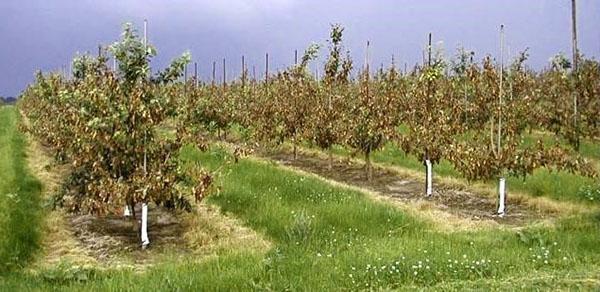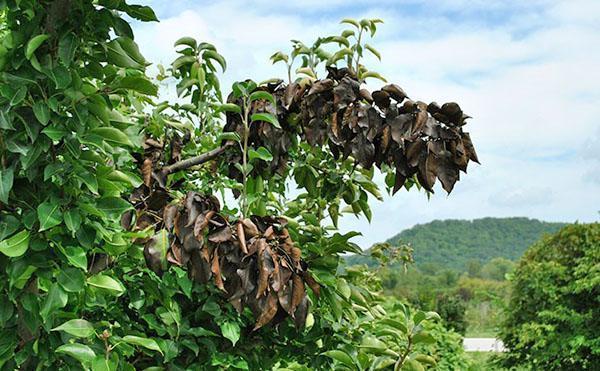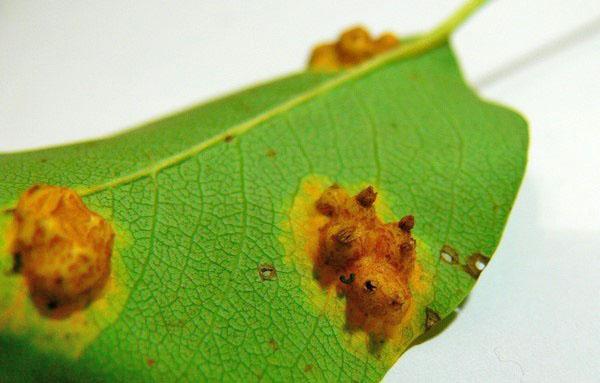Pests of pears on leaves and control measures
 Productivity, fruit taste and size are directly dependent on healthy leaves. Regardless, fungal, bacterial or insect pests of pears on the leaves - it is necessary to eradicate the infection. Usually, the prophylactic treatment of the garden is approached in a complex manner, with one measure they protect against several ailments. A gardener can prevent the appearance of a disease, or he can begin to fight when the disease is already ruining the crop.
Productivity, fruit taste and size are directly dependent on healthy leaves. Regardless, fungal, bacterial or insect pests of pears on the leaves - it is necessary to eradicate the infection. Usually, the prophylactic treatment of the garden is approached in a complex manner, with one measure they protect against several ailments. A gardener can prevent the appearance of a disease, or he can begin to fight when the disease is already ruining the crop.
Signs of disease
During the season, any yellowing, twisting or blackness of a single leaf or branch becomes a harbinger of pear disease. Despite preventive maintenance, at any time a disease or insect can be introduced from the outer perimeter of the garden. An attentive gardener, with a daily detour, will see a pear pest on the leaves. Diseases of pear leaves are caused by various factors:
- the tree is weakened by excessive harvest, has received bark damage or frost damage in winter;
- the pear received fungal leaf diseases - scab, fire blight, rust;
- the plant was attacked by insect pests.
Whatever the disease, it is reflected in the leaves. Diseases make them brown, black, dry. Insects damage the leaf blade, and this is clearly visible. Pests of pears on the leaves can disrupt the ovaries, damage the fruit. Each leaf works for photosynthesis - the formation of chlorophyll under the sun's rays. It is later processed into nutrients. Few leaves - the plant is starving.
Common pear diseases

The scourge of the hearth gardens of the present fire blight... It covers the gardens with lightning speed, at first the leaves look like scalded, or burnt by the sun. It is this disease that is most often the reason why the leaves of the pear turn black and curl. The disease was brought from Japan and America. Conventional drugs have little effect on it. Treatment is carried out with antibiotics - tetracycline series. For spraying pears, the solution is prepared at the rate of 2 tablets per bucket of water. But branches with obvious damage are cut out, and an open wound is treated with a solution of 2 tablets in 100 g of water. The cut site is closed with garden pitch.
With a strong spread of the disease on a single tree, it must be destroyed and burned.
 Another plague on pear leaves is rust. A fungal disease that develops on junipers, and then the spores are carried over long distances by the wind, infecting many types of trees. The first signs are the appearance of small yellow dots on a young leaf. They are noticeable. If left untreated, the disease goes inward, affects the leaf, and swellings appear on the back. They burst and spores infect a larger area of the pear garden. The leaves fall in the middle of summer, the shoots do not grow, the tree bark cracks.
Another plague on pear leaves is rust. A fungal disease that develops on junipers, and then the spores are carried over long distances by the wind, infecting many types of trees. The first signs are the appearance of small yellow dots on a young leaf. They are noticeable. If left untreated, the disease goes inward, affects the leaf, and swellings appear on the back. They burst and spores infect a larger area of the pear garden. The leaves fall in the middle of summer, the shoots do not grow, the tree bark cracks.
With the appearance of the first yellow spots on the leaves, you need to know what rust is on the pear and how to treat it. The disease is very persistent and takes years to heal. Preventive measures consist in treating the tree with fungicides 3 times per season - before the leaves appear, after flowering and again after 2 weeks. When rust appears, the plant is treated up to 6 times per season.Fungicides Kuproksat, Poliram, colloidal sulfur, Skor.
There are varieties of pears that are resistant to rust:
- summer pears - Chizhovskaya, Skorospelka, Ilyinka and others;
- autumn - Bere, Bosk, Borovinka red;
- rarely get sick in winter - Nika, Bere, Yakovlevskaya.
Pear insect pests
 Insects can cause no less damage to a pear, leave it without a crop, and destroy a young tree. From early spring, young shoots of the tree are colonized by aphids. Emerging from the trunk or the ground with the arrival of heat, it climbs the branches and begins hatching. As soon as the young leaves develop, they are colonized by aphids.
Insects can cause no less damage to a pear, leave it without a crop, and destroy a young tree. From early spring, young shoots of the tree are colonized by aphids. Emerging from the trunk or the ground with the arrival of heat, it climbs the branches and begins hatching. As soon as the young leaves develop, they are colonized by aphids.
For aphids on pears and apple trees, folk remedies are used. Until she twists the leaf, the insect can be washed off even with cold water from a hose. Spraying with infusion of garlic, celandine, dandelion, soap helps. But later, only insecticides can cope with the scourge. Preventive spraying can be carried out before the leaves bloom, before flowering and on young ovaries. A sticky trapping belt installed on the trunk will prevent aphids from rising from the ground, whitewashing will destroy the eggs on the trunk.
 If clean, intact leaves of a pear are curled - what to do? We looked through the years of a nondescript gray butterfly - leaf rollers. She laid her eggs, the caterpillars came out. They put poison into the juice, from which the leaf cells changed shape and the leaf curled up into a tube. In the future, the leaf darkens, turns black, falls off. You can lose up to 80% of the foliage. In the summer, when the fruit is being poured, chemical preparations cannot be used, and folk remedies hardly help. You can use biological compounds - Bitoxibacillin and Lepidocide, or enzymes - Fitoverm, Akarin. This genus of insects has up to 10 thousand species.
If clean, intact leaves of a pear are curled - what to do? We looked through the years of a nondescript gray butterfly - leaf rollers. She laid her eggs, the caterpillars came out. They put poison into the juice, from which the leaf cells changed shape and the leaf curled up into a tube. In the future, the leaf darkens, turns black, falls off. You can lose up to 80% of the foliage. In the summer, when the fruit is being poured, chemical preparations cannot be used, and folk remedies hardly help. You can use biological compounds - Bitoxibacillin and Lepidocide, or enzymes - Fitoverm, Akarin. This genus of insects has up to 10 thousand species.
Prevention against leaf rollers on a pear consists of the following measures:
- spring whitewashing of boles and places of exit of skeletal branches with lime;
- tree processing on dormant buds from all wintering ones with Preparation 30;
- collection of leaves and fallen fruits in caterpillars;
- hanging traps with fermented bait;
- use of trapping belts.
In the early summer, during the summer of the butterfly, insecticides can be used. Contact chemicals can be used in warm weather. In cold weather, caterpillars hide in a cocoon and are inaccessible.
 Another attack on a pear is a gall mite. It is a tiny cephalopod worm less than 1 mm in size with four legs. They are white or pink. Infection occurs by wind or the pest is carried on clothes and shoes.
Another attack on a pear is a gall mite. It is a tiny cephalopod worm less than 1 mm in size with four legs. They are white or pink. Infection occurs by wind or the pest is carried on clothes and shoes.
Folk remedies in the fight against gall mites do not help. The target insecticide for this pest is Vertimec and Proclame. The tree is cultivated completely in early spring, after harvest and before frost.
 The pest is called pear flower beetle or weevil. A small, less than 5 mm nondescript bug can leave a tree without a crop. Since autumn, he mines fruit buds on a pear, in spring they do not bloom, they are eaten from the inside by beetle larvae. In summer, females lay eggs in the fruit.
The pest is called pear flower beetle or weevil. A small, less than 5 mm nondescript bug can leave a tree without a crop. Since autumn, he mines fruit buds on a pear, in spring they do not bloom, they are eaten from the inside by beetle larvae. In summer, females lay eggs in the fruit.
If a weevil is found on a pear, how to fight?
Before flowering, treatment is carried out against the weevil with strong preparations - Karbofos, Aktellik, Metaphos. During the period of swelling and opening of the buds in cold weather up to +10 degrees, the tree is shaken, and the beetles fall on the litter. They are drowned in water with kerosene.
Hello, please tell me what the pear is sick with, and how to treat it? Pear is 4 years old.
Hello, there are black worms on the pear leaves, what are these pests and how to deal with them?
If the crop is harvested, use fungicides.
On the pear there is probably a small white aphid, the leaves at the tops are strongly twisted, what should I do?